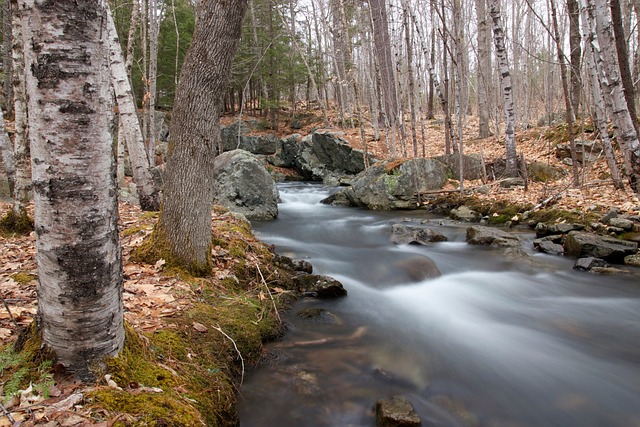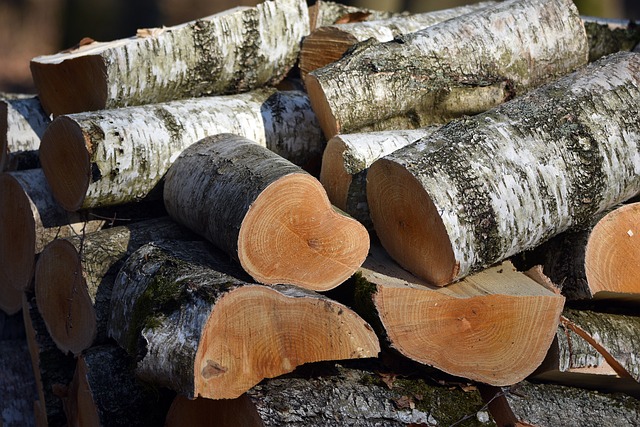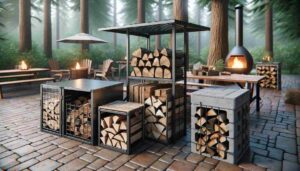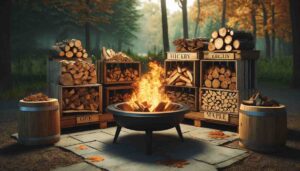Choosing the right firewood is crucial for a cozy and efficient fire. If you’ve ever wondered about the qualities of River Birch as firewood, you’ve come to the right place. Today, I’m going to tackle the question that’s been on your mind: “Is River Birch good firewood?”
Yes, River Birch can be good firewood with its readily available and sustainable nature, low moisture content for quick drying, pleasant aroma, and visually appealing bark. However, its faster burn rate and potential for sparks and popping require proper safety precautions.
But this is a little piece of the puzzle. In this comprehensive guide, I’ll explore its appearance, availability, density, burning qualities, and more. By the end of this article, you’ll have all the information you need to decide if River Birch is the ideal firewood choice for you. Let’s jump right in!
Understanding River Birch as Firewood
Before I delve into whether River Birch is good firewood or not, let’s first understand what River Birch actually is. River Birch, scientifically known as Betula nigra, is a deciduous tree that’s native to North America. It’s commonly found near riverbanks, hence its name, and is known for its beautiful peeling bark, which ranges from reddish-brown to creamy white.
Now, when it comes to using firewood, there are several important factors to consider. These factors greatly influence the burn quality and efficiency of the firewood. Let’s take a closer look at these factors to better understand how River Birch performs as firewood.
First and foremost, one crucial factor to consider is the moisture content of the firewood. The ideal moisture content for firewood is around 20%. When wood has a higher moisture content, it tends to burn less efficiently and produce more smoke. On the other hand, well-seasoned firewood with a lower moisture content burns hotter and more efficiently.
Density is another key factor to consider. Denser firewood generally burns longer and produces more heat. It’s important to note that different wood species have varying densities, which directly affects their burn characteristics.
Lastly, the energy content of firewood is an important consideration. It refers to the amount of heat energy produced when the wood is burned. Firewood with higher energy content provides more heat output and is generally preferred for heating purposes.
Now that you have a basic understanding of the factors involved, let’s explore the specific characteristics of River Birch as firewood and see how it measures up in terms of moisture content, density, burning qualities, and energy content.

Characteristics of River Birch as Firewood
When it comes to using River Birch as firewood, let’s start by discussing its appearance and availability. River Birch wood has a unique charm with its beautiful peeling bark and a range of colors from reddish-brown to creamy white. It adds a touch of natural beauty to your fire. In terms of availability, River Birch can be found in various regions of North America, particularly near riverbanks and wet areas.
Now, let’s talk about the density and moisture content of River Birch wood. In terms of density, River Birch falls in the medium range compared to other firewood options. It’s not as dense as hardwoods like oak or maple, but it’s not as light as softwoods either. As for moisture content, freshly cut River Birch typically has a high moisture content, which means it needs to be properly seasoned before use. With proper seasoning, River Birch can be dried relatively quickly, making it more suitable for use as firewood.
When it comes to burning qualities, River Birch has some positive attributes. It ignites easily, producing a quick flame and providing immediate warmth. It also has a pleasant aroma when burned, creating a cozy atmosphere around your fireplace or campfire. However, it’s important to note that River Birch tends to burn faster compared to denser hardwoods. This means you may need to add more logs to maintain a longer-lasting fire.
In terms of energy content, River Birch provides a moderate amount of heat output. While it may not generate as much heat as some hardwoods, it can still provide a comfortable and enjoyable fire experience.
It’s worth mentioning that one aspect to be cautious about when using River Birch as firewood is the potential for sparks and popping. The unique structure of the bark can sometimes lead to increased popping and the occasional spark. To ensure safety, it’s recommended to use a spark screen or mesh guard when burning River Birch.
Taking all these characteristics into consideration, River Birch can be a good option for firewood, especially if you appreciate its aesthetic appeal, quick ignition, and pleasant aroma. However, keep in mind its faster burn rate and potential for sparks, which may influence your decision depending on your specific needs and preferences.
Let’s move on to discussing the pros and cons of using River Birch in more detail.
Pros and Cons of Using River Birch as Firewood
Using River Birch as firewood comes with its own set of advantages and disadvantages. Let’s take a closer look at the pros and cons to help you make an informed decision.
Pros of River Birch Firewood:
- Easy Accessibility and Sustainability: River Birch is relatively easy to find, especially if you live in an area where it grows abundantly. Its availability makes it a convenient option for obtaining firewood. Additionally, River Birch is a fast-growing tree, which means it can be a sustainable choice if harvested responsibly.
- Quick Seasoning and Drying: River Birch has a relatively low moisture content compared to some other types of wood, making it easier to season and dry. With proper storage and seasoning techniques, you can prepare River Birch for burning in a shorter amount of time compared to denser hardwoods.
- Pleasant Aroma and Aesthetics: When burned, River Birch emits a pleasant aroma that adds a touch of natural fragrance to your fire. The beautiful peeling bark of River Birch also creates an attractive and rustic visual appeal, enhancing the overall ambiance of your fireplace or campfire.
Cons of River Birch Firewood:
- Faster Burn Rate: Due to its moderate density, River Birch tends to burn faster compared to denser hardwoods like oak or maple. This means you may need to add more logs more frequently to maintain a consistent and long-lasting fire. Keep this in mind if you’re looking for firewood that will provide extended burning times.
- Potential Sparks and Popping: River Birch has a unique bark structure, which can lead to increased popping and occasional sparks during burning. While this is not a significant concern when using proper safety measures, it’s important to be cautious and use a spark screen or mesh guard to prevent any potential hazards.
- Limited Longevity of the Fire: If you’re aiming for a fire that lasts for a longer duration, River Birch may not be the ideal choice. Its faster burn rate means that the fire may not sustain for extended periods without adding additional logs.
Considering these pros and cons, River Birch can still be a suitable option for firewood, especially if you value its easy accessibility, quick drying time, pleasant aroma, and aesthetic appeal. However, if you prioritize longer burning times or have specific safety concerns, you may want to explore alternative firewood options.
In the next section, I’ll provide some useful tips on how to use River Birch effectively as firewood to optimize your fire experience.
Tips for Using River Birch Firewood Effectively
To ensure you get the most out of your River Birch firewood, here are 4 useful tips to help you use it effectively:
- Proper Storage and Seasoning: To optimize the burn quality of River Birch firewood, it’s essential to properly store and season it. Start by storing the wood in a well-ventilated area, protected from rain and snow. Stack the logs in a neat and organized manner, allowing for proper airflow. Aim to season the wood for at least six months to a year, depending on the climate and initial moisture content. Regularly check the moisture level using a moisture meter, and ensure it reaches the optimal range of around 20% before use.
- Combining River Birch with Other Firewood: Consider combining River Birch with denser firewood options to enhance the longevity of your fire. Mixing River Birch with hardwoods like oak or maple can help slow down the burn rate and extend the overall burning time. This combination provides a balance between quick ignition and longer-lasting fires.
- Safety Precautions: Due to the potential for sparks and popping, it’s important to prioritize safety when using River Birch firewood. Always use a spark screen or mesh guard to prevent sparks from escaping the fire and causing any hazards. Maintain a safe distance between the fire and flammable objects, and never leave the fire unattended. Additionally, keep a fire extinguisher or a bucket of water nearby for emergencies.
- Experiment and Observe: Each firewood type has its unique characteristics, and the same goes for River Birch. As you use River Birch firewood, take note of its burning qualities, flame patterns, and heat output. Experiment with different combinations of firewood to find the balance that suits your preferences and desired fire experience. Observe how River Birch performs and make adjustments accordingly.
What is the difference between birch and river birch?
Birch and River Birch are different species of trees within the Betula genus. Here are some key differences between the two:
- Scientific Classification: Birch refers to the broader genus Betula, which encompasses various species of birch trees. River Birch, on the other hand, is a specific species known as Betula nigra.
- Habitat: Birch trees can be found in various regions and environments around the world, including North America, Europe, and Asia. River Birch, as the name suggests, is primarily found in North America, particularly in wetland areas and along riverbanks.
- Appearance: Birch trees, in general, have distinct characteristics such as smooth bark, slender trunks, and branches with a characteristic upward-sweeping shape. River Birch specifically stands out due to its unique peeling bark, which exposes different shades of reddish-brown and creamy white underneath.
- Bark Texture: Birch trees typically have smooth or lightly peeling bark. River Birch, in contrast, has a more pronounced peeling bark, with layers that curl and reveal the lighter-colored inner bark.
- Preferred Growing Conditions: While birch trees, in general, prefer moist and well-drained soils, River Birch is particularly adapted to thrive in wetland areas, along riverbanks, and in areas with higher moisture content in the soil.
It’s important to note that River Birch is a specific species of birch, and when people refer to “birch” without specifying a particular species, they are usually referring to the broader group of birch trees that encompass various species such as white birch (Betula papyrifera) and yellow birch (Betula alleghaniensis). Each species of birch may have its own unique characteristics and preferences when it comes to growth conditions and uses.
Is River Birch a hardwood or softwood?
River Birch is classified as a hardwood. Although its density is not as high as some other hardwoods like oak or maple, it is still considered a hardwood due to its botanical classification and the structure of its wood.
Is river birch easy to split?
Yes, River Birch is generally considered relatively easy to split compared to some other hardwoods. Its wood has a moderate density, which makes it more manageable for splitting, especially when compared to denser hardwoods. However, it’s worth noting that the ease of splitting can vary depending on factors such as the specific tree, the age of the wood, and the moisture content. Proper tools and techniques, such as using a sharp axe or a log splitter, can make the splitting process even easier.
What Wood Burns the Hottest? Exploring the Best Firewood for a Cozy Blaze
Conclusion
In conclusion, yes, River Birch can be good firewood under the right circumstances. River Birch has its advantages and disadvantages as firewood. On the positive side, River Birch is readily available and sustainable, making it convenient to acquire. It also has a relatively low moisture content, allowing it to season and dry relatively quickly compared to other types of wood. When burned, River Birch produces a pleasant aroma and adds a visually appealing touch with its beautiful peeling bark.
However, it’s important to note that River Birch has a faster burn rate compared to denser hardwoods. This means that it may not provide the same long-lasting fire as other options. Additionally, River Birch can produce more sparks and popping due to its unique bark structure, so it’s important to take proper safety precautions.
Ultimately, whether River Birch is good firewood depends on your specific needs and preferences. If you value easy accessibility, quick drying, and enjoy its aesthetic appeal, River Birch can be a suitable choice. However, if you prioritize longer burn times or have safety concerns, you may want to consider alternative firewood options such as denser hardwoods.
It’s always recommended to experiment and find the firewood that best suits your desired fire experience. Remember to properly store, season, and maintain a safe fire environment for an enjoyable and cozy fire every time.
Remember, firewood selection is a personal choice, and it’s always worth experimenting and finding the right combination that suits your preferences and provides the cozy fire experience you desire.
So, next time you’re gathering firewood, consider the qualities of River Birch and make an informed decision based on what matters most to you. Enjoy the warmth, ambiance, and relaxation that well-chosen firewood can bring to your home or outdoor space!
Happy burning!










